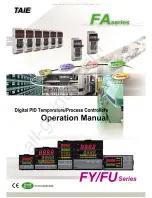
Optical Sensor Requirements
When used as safeguarding devices, optical sensors are described by IEC61496-1/-2/-3 as Active Opto-electronic
Protective Devices (AOPD) and Active Opto-electronic Protective Devices responsive to Diffuse Reflection (AOPDDR).
AOPDs include safety light screens (curtains) and safety grids and points (multiple-/single-beam devices). These devices
generally meet Type 2 or Type 4 design requirements. A Type 2 device is allowed to be used in a Category 2 application,
per ISO 13849-1, and a Type 4 device can be used in a Category 4 application.
AOPDDRs include area or laser scanners. The primary designation for these devices is a Type 3, for use in up to Category 3
applications.
Optical safety devices must be placed at an appropriate safety distance (minimum distance), according to the application
standards. Refer to the applicable standards and to manufacturer documentation specific to your device for the appropriate
calculations. The response time of the Safety Controller outputs to each safety input is provided on the Configuration
Summary tab in the Software.
If the application includes a pass-through hazard (a person could pass through the optical device beams and stand
on page 42).
7.5.8 Two-Hand Control
The Safety Controller may be used as an initiation device for most powered machinery when machine cycling is
controlled by a machine operator.
The Two-Hand Control (THC) actuators must be positioned so that hazardous motion is completed or stopped before the
operator can release one or both of the buttons and reach the hazard (see
Two-Hand Control Safety Distance (Minimum
on page 34).
The Safety Controller safety inputs used to monitor the actuation of the hand controls for two-hand control comply with the
functionality of Type III requirements of IEC 60204-1 and ISO 13851 (EN 574) and the requirements of ANSI NFPA79 and
ANSI B11.19 for two-hand control, which include:
• Simultaneous actuation by both hands within a 500 ms time frame
• When this time limit is exceeded, both hand controls must be released before operation is initiated
• Continuous actuation during a hazardous condition
• Cessation of the hazardous condition if either hand control is released
• Release and re-actuation of both hand controls to re-initiate the hazardous motion or condition (anti-tie down)
• The appropriate performance level of the safety-related function (Control Reliability, Category/Performance level, or
appropriate regulation and standard, or Safety Integration Level) as determined by a risk assessment
WARNING: Point-of-Operation Guarding
When properly installed, a two-hand control device provides protection only for the hands of the machine
operator. It may be necessary to install additional safeguarding, such as safety light screens, additional
two-hand controls, and/or hard guards, to protect all individuals from hazardous machinery.
Failure to properly guard hazardous machinery can result in a dangerous condition which could lead to
serious injury or death.
CAUTION: Hand Controls
The environment in which hand controls are installed must not adversely affect the means of actuation.
Severe contamination or other environmental influences may cause slow response or false On conditions
of mechanical or ergonomic buttons. This may result in exposure to a hazard.
The level of safety achieved (for example, ISO 13849-1 Category) depends in part on the circuit type selected.
Consider the following when installing hand controls:
• Failure modes, such as a short circuit, a broken spring, or a mechanical seizure, that may result in not detecting the
release of a hand control
• Severe contamination or other environmental influences that may cause a slow response when released or false ON
condition of the hand control(s), for example, sticking of a mechanical linkage
• Protection from accidental or unintended operation, for example, mounting position, rings, guards, or shields
• Minimizing the possibility of defeat, for example, hand controls must be far enough apart so that they cannot be
operated by the use of one arm—typically, not less than 550 mm (21.7 in) in a straight line, per ISO 13851
• The functional reliability and installation of external logic devices
• Proper electrical installation per NEC and NFPA79 or IEC 60204
XS/SC26-2 and SC10-2 Safety Controllers
www.bannerengineering.com - Tel: + 1 888 373 6767
33
















































